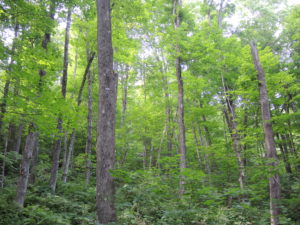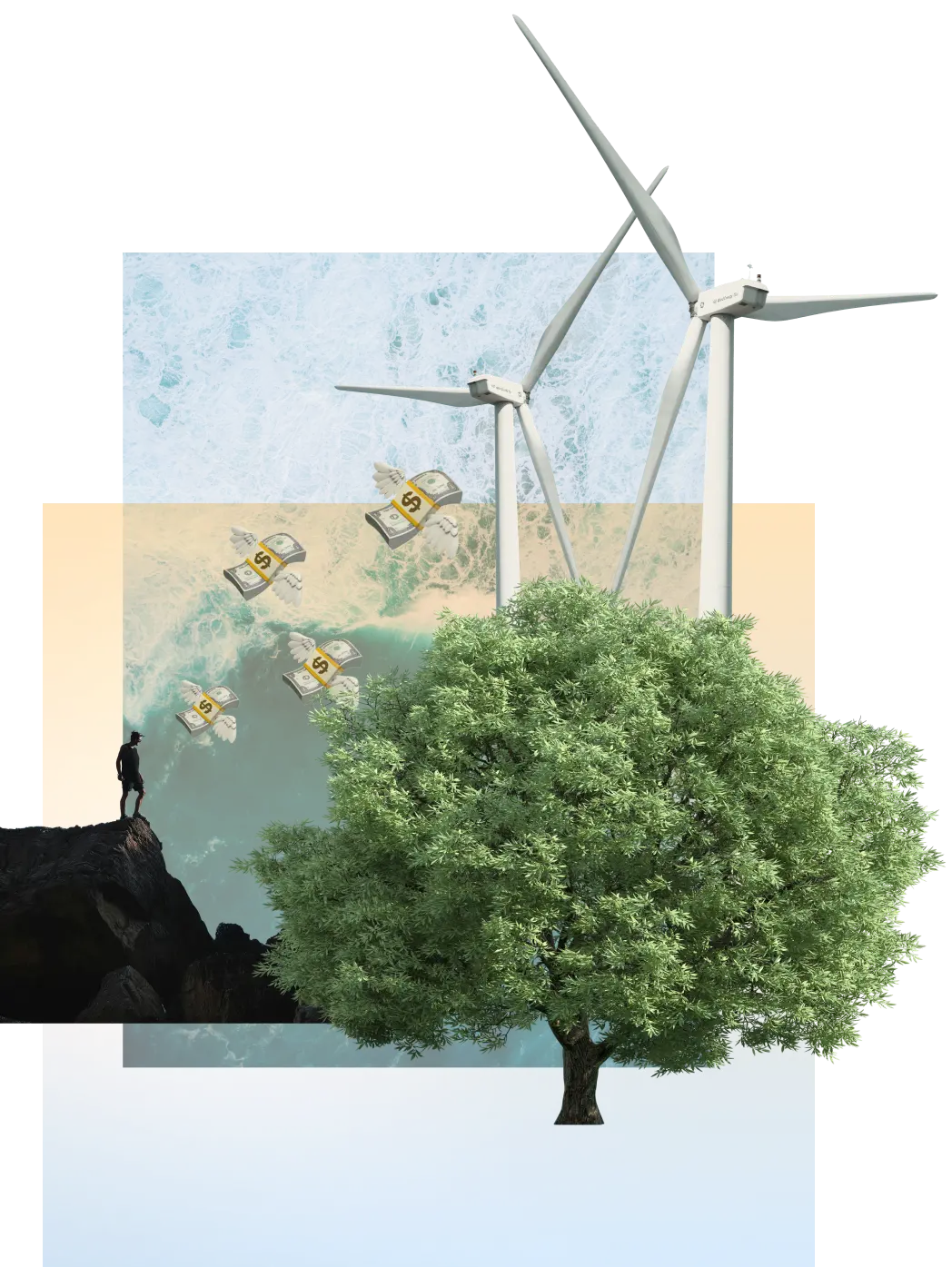How to Conserve Forever-Wild Landscapes with the Northeast Wilderness Trust

Tall, untamed old forests. Diverse, rich wildlife. These are the natural lands that Northeast Wilderness Trust (NEWT) works to conserve and keep wild––forever. Based in Vermont, Maine, and Massachusetts, the Wilderness Trust safeguards more than 64,000 forever-wild acres across New England and New York. As a society, when we make the choice to protect wilderness––we’re undeniably rewarded with incredible gifts. Conservation allows for biodiversity, carbon storage, resilience and finally, reciprocity. We sat down with Sophi Veltrop, Outreach Manager for NEWT, to chat all about getting involved in environmental philanthropy, how to orient our wilderness conservation efforts, and more.
Read on to learn how to participate in the conservation of forever-wild landscapes:
Growing up, did you have a clear idea of what your future profession would be?
I loved nature as a kid. I spent most of my time playing in a small patch of forest behind my home and building fairy houses. So, you know, I think growing up fascinated by nature, conservation was a natural fit. But it definitely took me a while to narrow down exactly what the right path was for me. I went to school in St. Louis, MO, at Washington University and I studied environmental science. Once out of school, I dabbled in a bunch of different things, including farming. I had a short seasonal gig as a field assistant, trapping mosquitoes to test for West Nile virus. So I kind of had a circuitous route until I finally landed a job in conservation in Vermont and later ended up at Northeast Wilderness Trust.
What attracted you to the world of nature conservation?
Well, I’ve always had a deep love of nature and affinity for all the wild creatures around us, and it just really pains me that so much of their habitat, and so many species are being destroyed––ultimately because humans want more resources than we actually need. We love to consume these goods, so many of which are not necessary at all. So this work just feels very necessary. With all this destruction, protecting nature just feels like a very clear, unequivocal thing that the world needs and a path forward to making the world a better place for people and nature alike.
Can you tell us more about what the Northeast Wilderness Trust is?
Absolutely. So Northeast Wilderness Trust protects wild landscapes forever. We preserve wild places, which means that they won’t be logged in the future. They won’t be used for extractive purposes like mining and farming. And of course, you know, we need natural resources, lumber and food, and all of that. But we also need places in the landscape where we know that nature is going to have a home forever. And so that’s why the Northeast Wilderness Trust exists. We are the only land trust in the region of the northeast that focuses exclusively on that kind of conservation–– where the forest, the wetlands, the rivers are always going to be there for the natural processes to unfold and for all of the creatures there to evolve at their own pace.
We were founded in 2002, so we’re delighted to be celebrating our 20th Anniversary this year. To date, we’ve protected 64,000 acre. The founders were a group of individuals who were involved in conservation in general, but saw the need for a land trust that was specifically focused on wilderness in this region. They saw that the vacant niche of wilderness conservation was not filled in the northeast, and so they got together, formed a board, and established a nonprofit 501(c )(3). Kathleen Fitzgerald was the first staff person; she was the executive director for several years. And so the trust grew over time. Today we have a little over a dozen employees.
Amazing! Do you have any advice on how the younger generation can get involved with philanthropy?
Something I love about Gen E and specifically thinking about our generation being able to make a difference, is the ease of donating through an app–– it’s very user friendly. I also love the way Gen E is linked to spending because I personally feel that my spending is mostly on resources that I’m using from the natural world–putting gas in my car, food in my belly, and so on. Offering a portion of that back into the natural world is a way of giving back. It’s this way of making that rare reciprocity a part of everyday purchases, and by extension, everyday life. And I think that feels really intuitively logical. Just having an app is a good fit for our generation.
I guess the other thing I would say is our generation is the one that’s saddled with so much student debt and having a really hard time buying homes. It can be hard to feel like you can make a difference, but there is power in the many. The total sum is much greater than the individual parts. And so being a part of something where you can feel really effective, it’s refreshing that you don’t have to be giving a huge amount, or be breaking the bank to make a difference. Everybody can do it in a small way that’s sustainable for their own livelihood––I think that’s a great place to start with philanthropy.
How does your foundation foster action to address climate change?
We are really focused on natural climate solutions when it comes to climate change. As we know, natural ecosystems store carbon. They are carbon strongholds and they’re also taking carbon out of the atmosphere. There’s a lot of misconception that old forests aren’t as good at removing carbon. But actually, recent research is showing that old forests are actually a critical, irreplaceable ally in the climate fight. Not only are they storing massive amounts of carbon, but they are still sequestering––pulling carbon out of the atmosphere–– and the soils can hold such immense amounts of carbon. So that’s really what we’re focusing on is bringing those old forests back to the northeast.


What are three main lessons that could help Gen E readers orient their wilderness conservation efforts?
- Northeast Wilderness Trust’s conservation efforts are only possible because of the financial support of our donors, both large and small. If you have the means, I can’t express enough how much micro-philanthropy matters. And if micro-philanthropy is beyond your means, there’s still room for you in the rewilding movement–through volunteering time and skills, attending events, learning more, and sharing your enthusiasm and knowledge about rewilding with your community.
- Learning how to use the resources that exist more wisely and more sparingly is an essential complementary measure to conservation efforts. Everything from wood, to plastic, to oil and gas. There’s very little wilderness out there. Only 3% of the Northeast has wilderness level protections on it, 97% of the northeast is available for extraction of resources or is developed already. We need a new plan for natural resource spending– and that plan needs to include space for the rest of creation to survive and thrive.
- As an environmentalist, thinking constantly about how to reduce your carbon footprint and your trash impact––it can be really stressful. And it can really feel like a perfectionist game. And that’s not fun for anyone. But working in wilderness conservation helped me change how I think about minimizing my impact on the earth. It can be an act of relationship, a way of showing up and giving back as a member in the family of life. Reducing personal consumption, even though it’s a small drop in the bucket, is important and it’s part of rewilding. (And I am by no means saying I’m perfect or carbon neutral!) In the same vein, conservation feels more and more like an act of kindness and reciprocity.
Is there something you wish the Northeast Wilderness Trust could address, but can’t just yet?
Oh yes, we always want to protect more lands. And we’re working on that. I would love to get even more schools visiting our preserves, but in the past we haven’t really had the capacity to. We have school field trips happening to our preserve in Massachusetts. Our staff member who lives down there has done a great job integrating local schools and facilitating student science projects and outdoor classroom days. I’d love to see that kind of thing replicated in each state that we work in.
What does the future look like for Northeast Wilderness Trust?
We’ve got some exciting projects under way. Right now we’ve got a land protection campaign in central Vermont and one in New York just west of the Adirondack Park. In total, our land protection team is actively working towards the protection of 25,000 acres across the region.
Is there anything else that you wish people knew about the Northeast Wilderness Trust?
Something exciting about Northeast Wilderness Trust is that we are putting an emphasis on reciprocity with wild places. Wilderness doesn’t have to be a far-off or difficult-to-access, exclusionary place. It’s about people creating relationships and familiarity, and rekindling our affection for everybody else who calls this planet home. The places that we protect are not only here for animals and plants, but also for people to experience wild nature on a meaningful, personal level.
——————————————————————————————————–
Here at Gen E, we’ve done the heavy lifting by narrowing down a list of environmental nonprofits doing the most impactful, innovative, and scalable work. These high-performing orgs are working on everything from clean energy to conservation. If you’d like to donate to the Northeast Wilderness Trust, they are one of our approved nonprofit beneficiaries and can be added to your Environmental Portfolio at any time.



